Optimized Super-Wideband MIMO Antenna with High Isolation for IoT Applications
Abstract
:1. Introduction
2. Antenna Design and Methodology
2.1. Antenna Geometry
2.2. SWB Antenna with Four Ports
Diversity Analysis
3. Results and Discussion
4. Conclusions
Author Contributions
Funding
Conflicts of Interest
References
- Doll, A.; Harel, J.P. Technology Challenges in Massive-MIMO Radiating Platforms. In Proceedings of the 2017 Sixth Asia-Pacific Conference on Antennas and Propagation (APCAP), Xi’an, China, 16–19 October 2017. [Google Scholar]
- Federal Communications Commission. Revision of Part 15 of the Commission’s Rules Regarding Ultra-Wideband Transmission Systems; First Report and Order; Federal Communications Commission: Washington, DC, USA, 2002; pp. 2–48.
- Tang, Z.; Zhan, J.; Wu, X.; Xi, Z.; Wu, S. Simple ultra-wider-bandwidth MIMO antenna integrated by double decoupling branches and square-ring ground structure. Microw. Opt. Technol. Lett. 2020, 62, 1259–1266. [Google Scholar] [CrossRef]
- Jensen, M.A.; Wallace, J.W. A review of antennas and propagation for MIMO wireless communications. IEEE Trans. Antennas Propag. 2004, 52, 2810–2824. [Google Scholar] [CrossRef] [Green Version]
- Dhar, S.K.; Sharawi, M.S. A UWB semi-ring MIMO antenna with isolation enhancement. Microw. Opt. Technol. Lett. 2015, 57, 1941–1946. [Google Scholar] [CrossRef]
- Su, S.-W.; Lee, C.-T.; Chang, F.-S. Printed MIMO-antenna system using the neutralization-line technique for wireless USB-dongle applications. IEEE Trans. Antennas Propag. 2011, 60, 456–463. [Google Scholar] [CrossRef]
- Wong, H.S.; Kibria, S.; Islam, M.T. Hexa band Mimo antenna with neutralization line for LTE mobile device application. Microw. Opt. Technol. Lett. 2016, 58, 1198–1204. [Google Scholar]
- Chen, W.S.; Lin, C.-H.; Lee, B.-Y.; Hsu, W.-H.; Chang, F.-S. Monopole slot antenna design for WLAN MIMO application. Microw. Opt. Technol. Lett. 2012, 54, 1103–1107. [Google Scholar] [CrossRef]
- Yang, D.-G.; Kim, D.O.; Kim, C.-Y. Design of dual-band MIMO monopole antenna with high isolation using slotted CSRR for WLAN. Microw. Opt. Technol. Lett. 2014, 56, 2252–2257. [Google Scholar] [CrossRef]
- Obara, T.; Suyama, S.; Shen, J. Joint processing of analog fixed beamforming and CSI-based precoding for Super High bit rate massive MIMO transmission using higher frequency bands. IEICE Trans. Commun. 2015, E98-B, 1474–1481. [Google Scholar] [CrossRef]
- Plicanic, V.; Vasilev, I.; Tian, R. Capacity maximization of handheld MIMO terminal with adaptive matching in the indoor environment. IET Electron. Lett. 2011, 47, 900–901. [Google Scholar] [CrossRef] [Green Version]
- Vasilev, I.; Plicanic, V.; Lau, B.K. Impact of antenna design on MIMO performance for compact terminals with adaptive impedance matching. IEEE Trans. Antennas Propag. 2016, 64, 1454–1465. [Google Scholar] [CrossRef] [Green Version]
- Okan, T. A compact octagonal-ring monopole antenna for super wideband applications. Microw. Opt. Technol. Lett. 2020, 62, 1237–1244. [Google Scholar] [CrossRef]
- Alluri, S.; Nakkeeran, R. Compact high bandwidth dimension ratio steering-shaped super wideband antenna for future wireless communication applications. Microw. Opt. Technol. Lett. 2020, 62, 3985–3991. [Google Scholar] [CrossRef]
- Singhal, S.; Singh, A.K. CPW-fed hexagonal Sierpinski super wideband fractal antenna. IET Microw. Antennas Propag. 2016, 10, 1701–1707. [Google Scholar] [CrossRef]
- Aziz, S.Z.; Jamlos, M.F. Compact super wideband patch antenna design using diversities of reactive loaded technique. Microw. Opt. Technol. Lett. 2016, 58, 2811–2814. [Google Scholar] [CrossRef]
- Ul Haq, M.A.; Koziel, S. Feedline Alterations for Optimization-Based Design of Compact Super-Wideband MIMO Antennas in Parallel Configuration. IEEE Antennas Wirel. Propag. Lett. 2019, 18, 1986–1990. [Google Scholar] [CrossRef]
- Mathur, R.; Dwari, S. Compact 4-Port MIMO/diversity antenna with low correlation for UWB application. Frequenz 2018, 72, 429–435. [Google Scholar] [CrossRef]
- Tripathi, S.; Mohan, A.; Yadav, S. A compact Koch fractal UWB MIMO antenna with WLAN band-rejection. IEEE Antennas Wirel. Propag. Lett. 2015, 14, 1565–1568. [Google Scholar] [CrossRef]
- Sipal, D.; Abegaonkar, M.P.; Koul, S.K. Easily extendable compact planar UWB MIMO antenna array. IEEE Antennas Wirel. Propag. Lett. 2017, 16, 2328–2331. [Google Scholar] [CrossRef]
- Yu, C.; Yang, S.; Chen, Y.; Wang, W.; Zhang, L.; Li, B.; Wang, L. A super-wideband and high isolation MIMO antenna system using a windmill-shaped decoupling structure. IEEE Access 2020, 8, 115767–115777. [Google Scholar] [CrossRef]
- Kumar, P.; Urooj, S.; Malibari, A. Design and Implementation of Quad-Element Super-Wideband MIMO Antenna for IoT Applications. IEEE Access 2020, 8, 226697–226704. [Google Scholar] [CrossRef]
- Oni, M.A.I.; Shehab, S.H.; Hassan, S.; Dey, S. Design and analysis of a low-profile, elliptical patch Super Wide Band (SWB) MIMO antenna. In Proceedings of the 2015 International Conference on Advances in Electrical Engineering (ICAEE), Dhaka, Bangladesh, 17–19 December 2015. [Google Scholar]
- Hassan, M.M.; Rasool, M.; Asghar, M.U.; Zahid, Z.; Khan, A.A.; Rashid, I.; Rauf, A.; Bhatti, F.A. A novel UWB MIMO antenna array with band notch characteristics using parasitic decoupler. J. Electromagn. Waves Appl. 2020, 34, 1225–1238. [Google Scholar] [CrossRef]
- Raheja, D.K.; Kanaujia, B.K.; Kumar, S. Low profile four-port super-wideband multiple-input-multiple-output antenna with triple-band rejection characteristics. Int. J. RF Microw. Comput.-Aided Eng. 2019, 29, e21831. [Google Scholar] [CrossRef]
- Kumar, P.; Urooj, S.; Alrowais, F. Design of quad-port MIMO/Diversity antenna with triple-band elimination characteristics for super-wideband applications. Sensors 2020, 20, 624. [Google Scholar] [CrossRef] [PubMed] [Green Version]
- Sharma, M.; Dhasarathan, V.; Patel, S.K.; Nguyen, T.K. An ultra-compact four-port 4 × 4 super-wideband MIMO antenna including mitigation of dual notched bands characteristics designed for wireless network applications. AEU Int. J. Electron. Commun. 2020, 123, 153332. [Google Scholar] [CrossRef]
- Khan, M.I.; Khattak, M.I.; Rahman, S.U.; Qazi, A.B.; Telba, A.A.; Sebak, A. Design and Investigation of Modern UWB-MIMO Antenna with Optimized Isolation. Micromachines 2020, 11, 432. [Google Scholar] [CrossRef] [PubMed] [Green Version]
- Singhal, S. Feather-shaped super wideband MIMO antenna. Int. J. Microw. Wirel. Technol. 2021, 13, 94–102. [Google Scholar] [CrossRef]
- Namani, S.; Gonen, B. Smart Agriculture Based on IoT and Cloud Computing. In Proceedings of the 2020 3rd International Conference on Information and Computer Technologies (ICICT), San Jose, CA, USA, 9–12 March 2020. [Google Scholar]
- Ahad, A.; Tahir, M.; Sheikh, M.A.; Ahmed, K.I.; Mughees, A.; Numani, A. Technologies trend towards 5G network for smart health-care using IoT: A review. Sensors 2020, 20, 4047. [Google Scholar] [CrossRef]
- Balani, W.; Sarvagya, M.; Samasgikar, A.; Ali, T.; Kumar, P. Design and Analysis of Super wideband Antenna for Microwave Applications. Sensors 2021, 21, 477. [Google Scholar] [CrossRef]
- Sayidmarie, K.H.; Fadhel, Y.A. Design aspects of UWB printed elliptical monopole antenna with impedance matching. In Proceedings of the 2012 Loughborough Antennas & Propagation Conference (LAPC), Loughborough, UK, 12–13 November 2012; pp. 1–4. [Google Scholar]
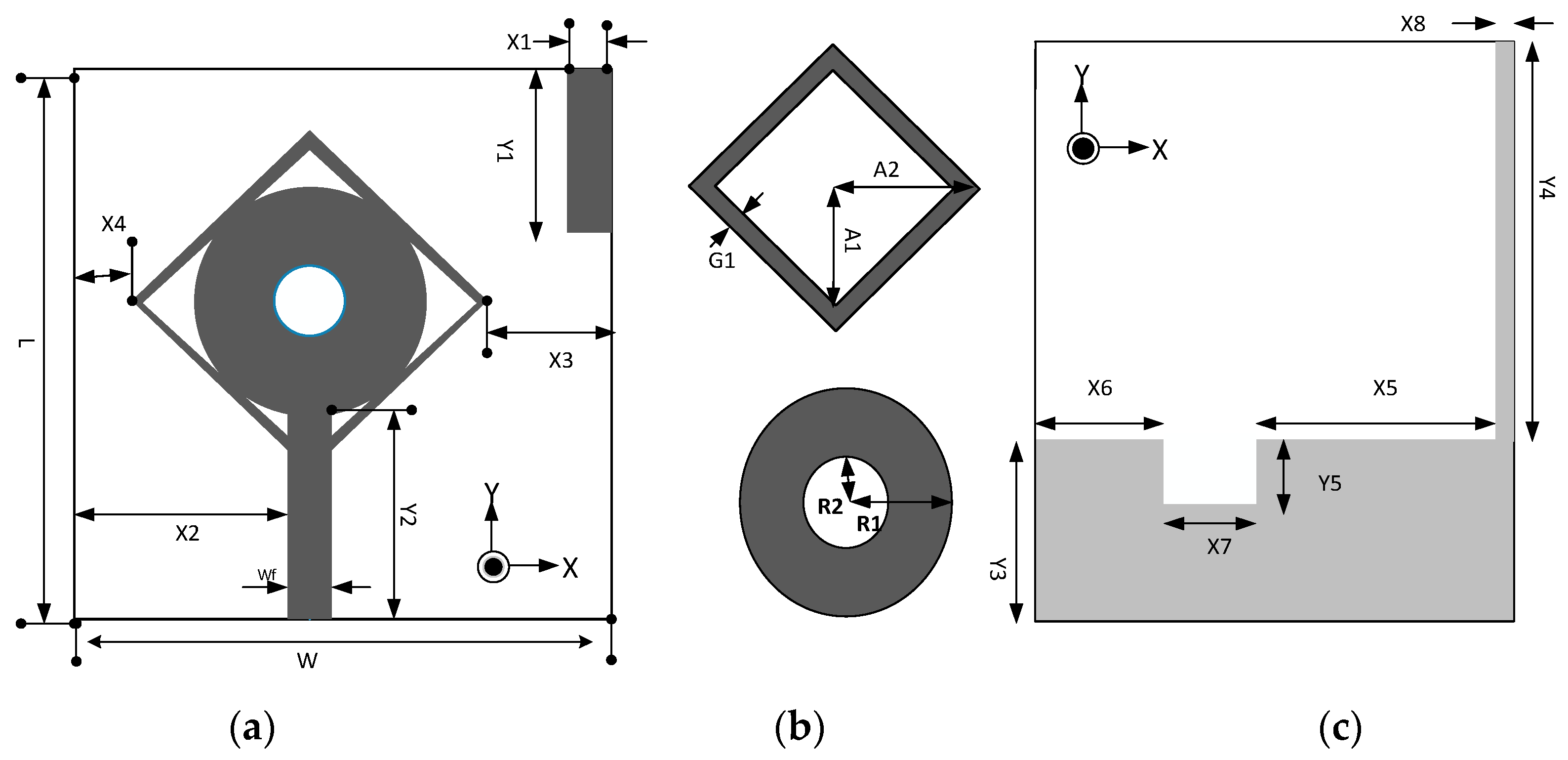
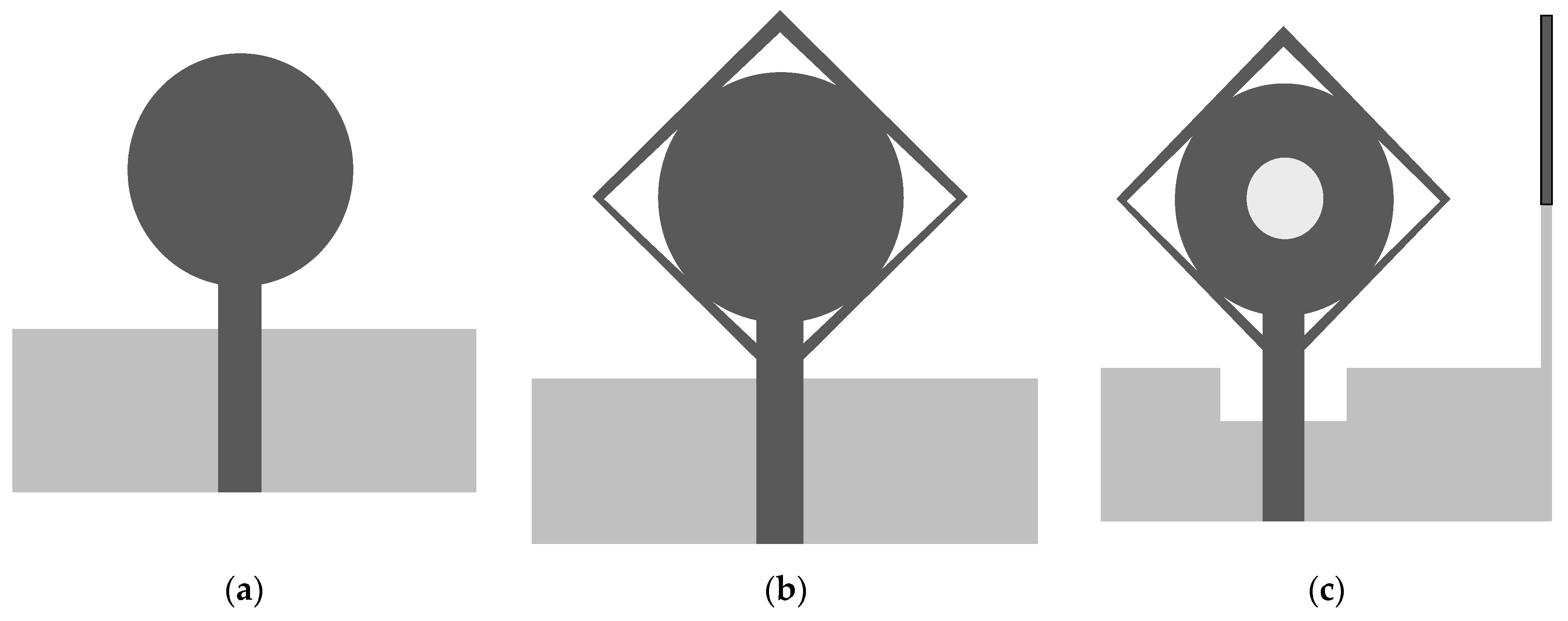

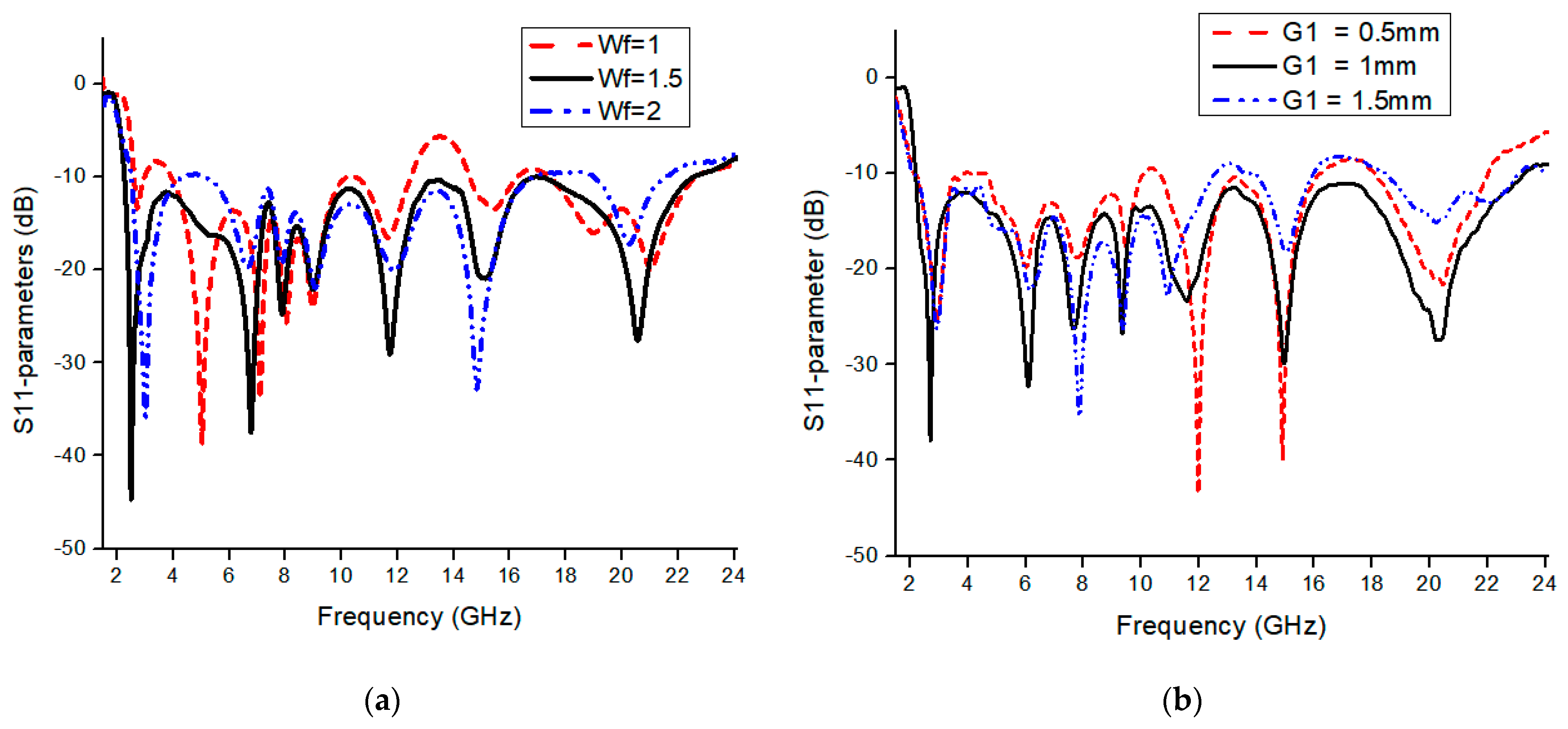

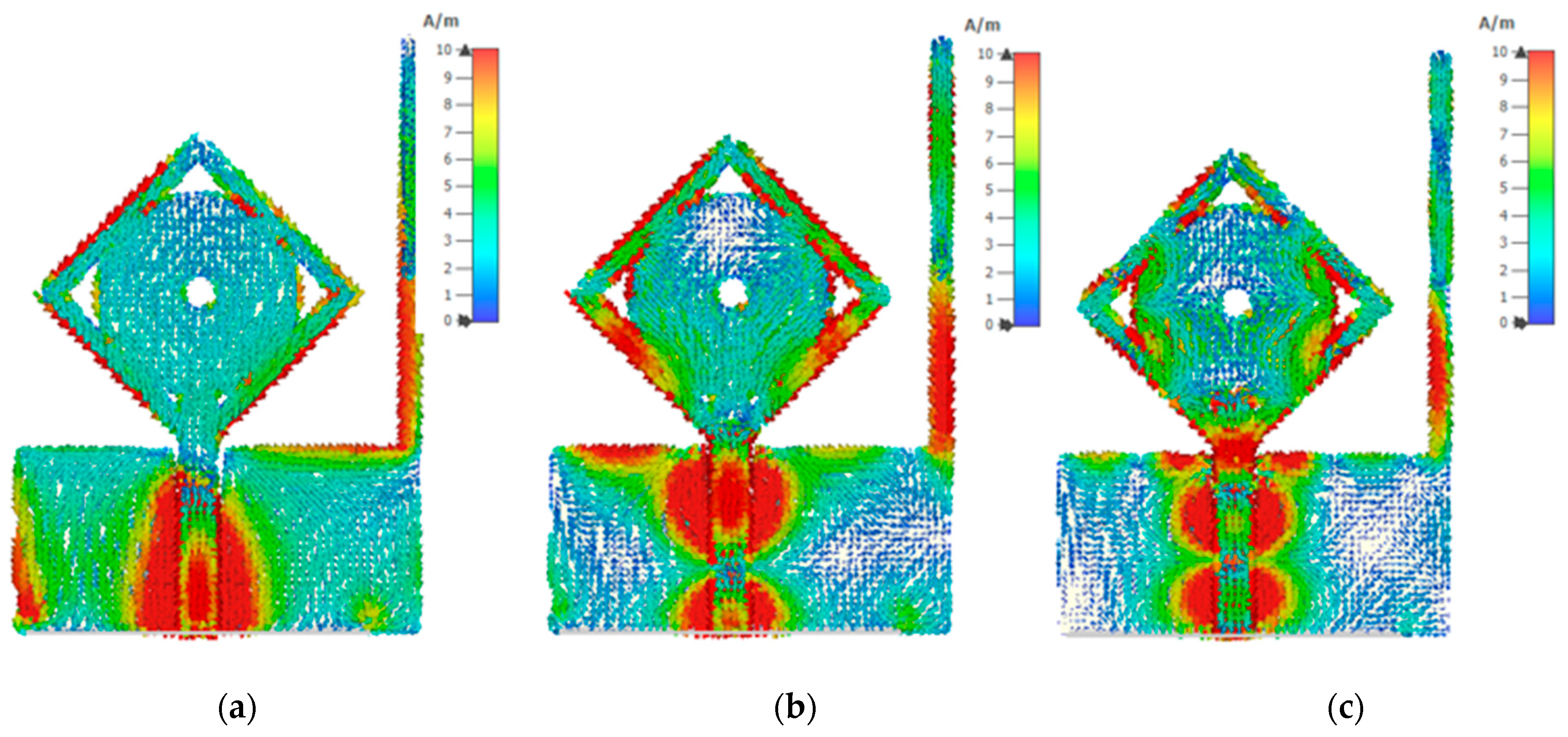

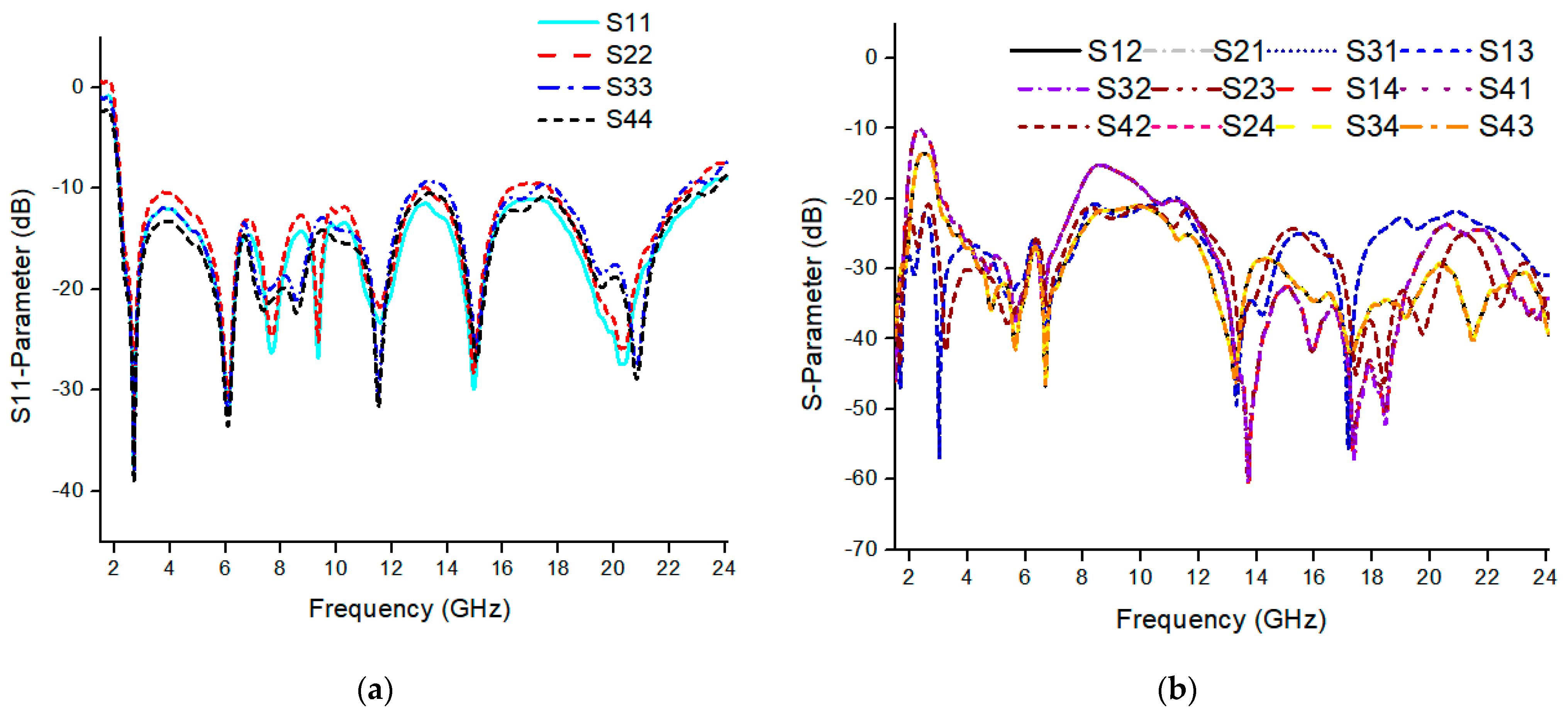
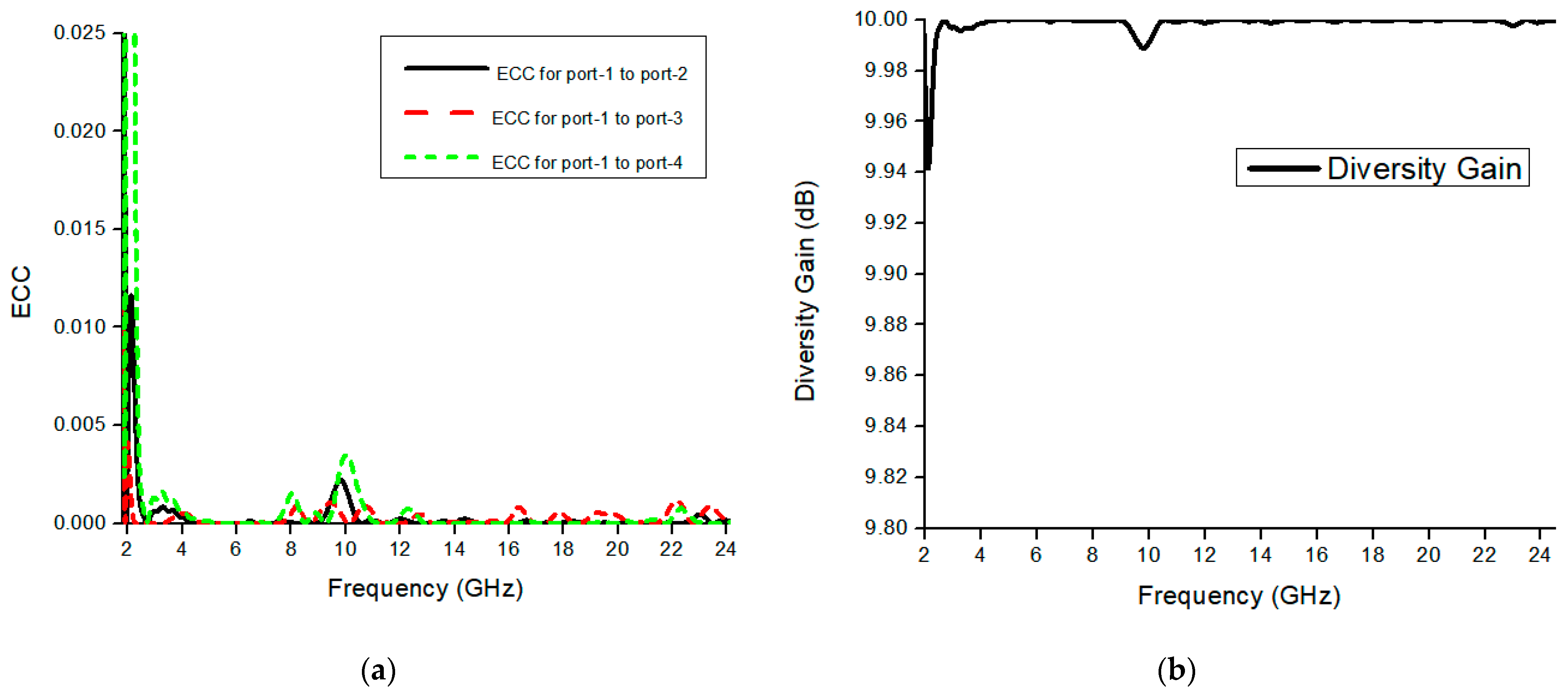

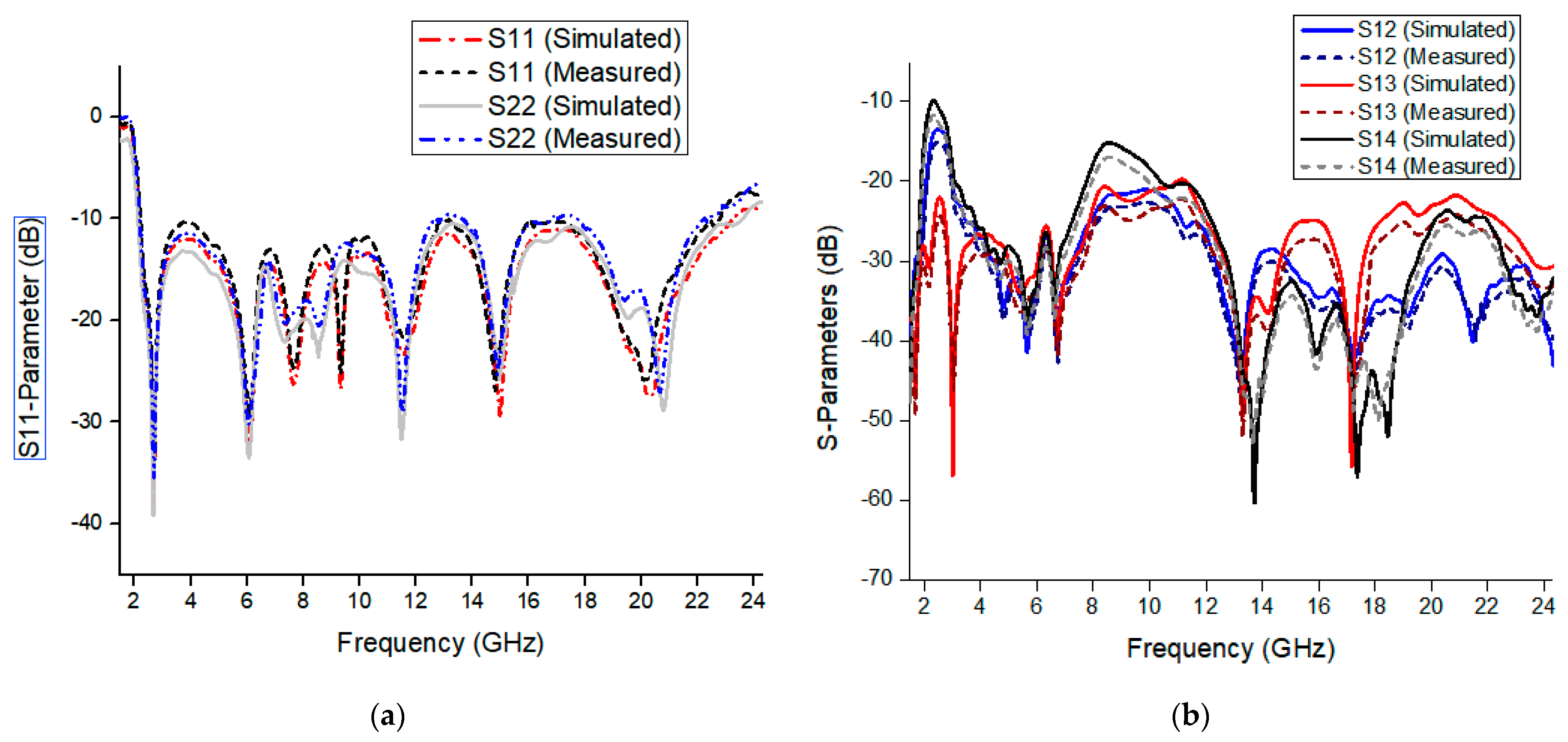
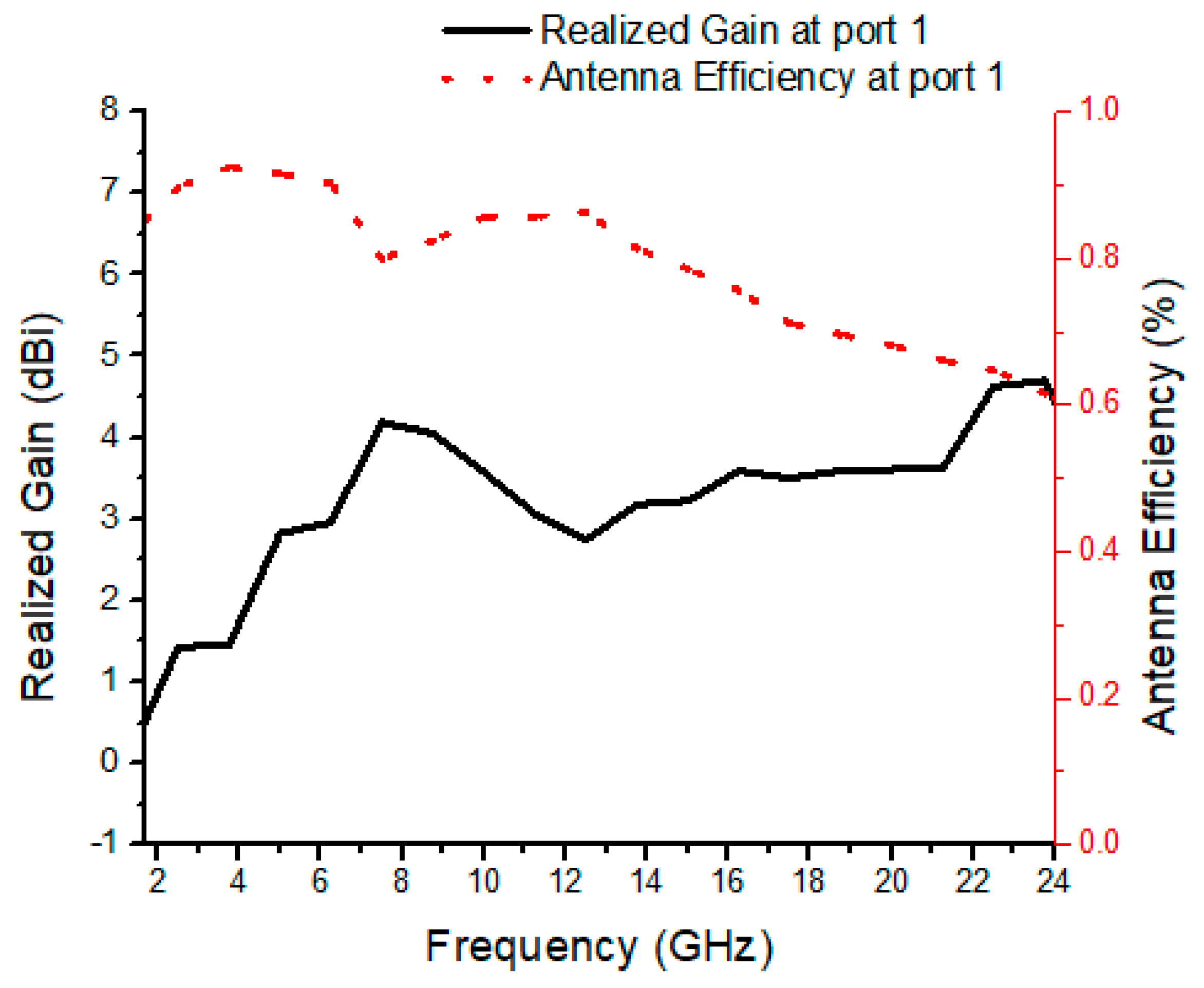
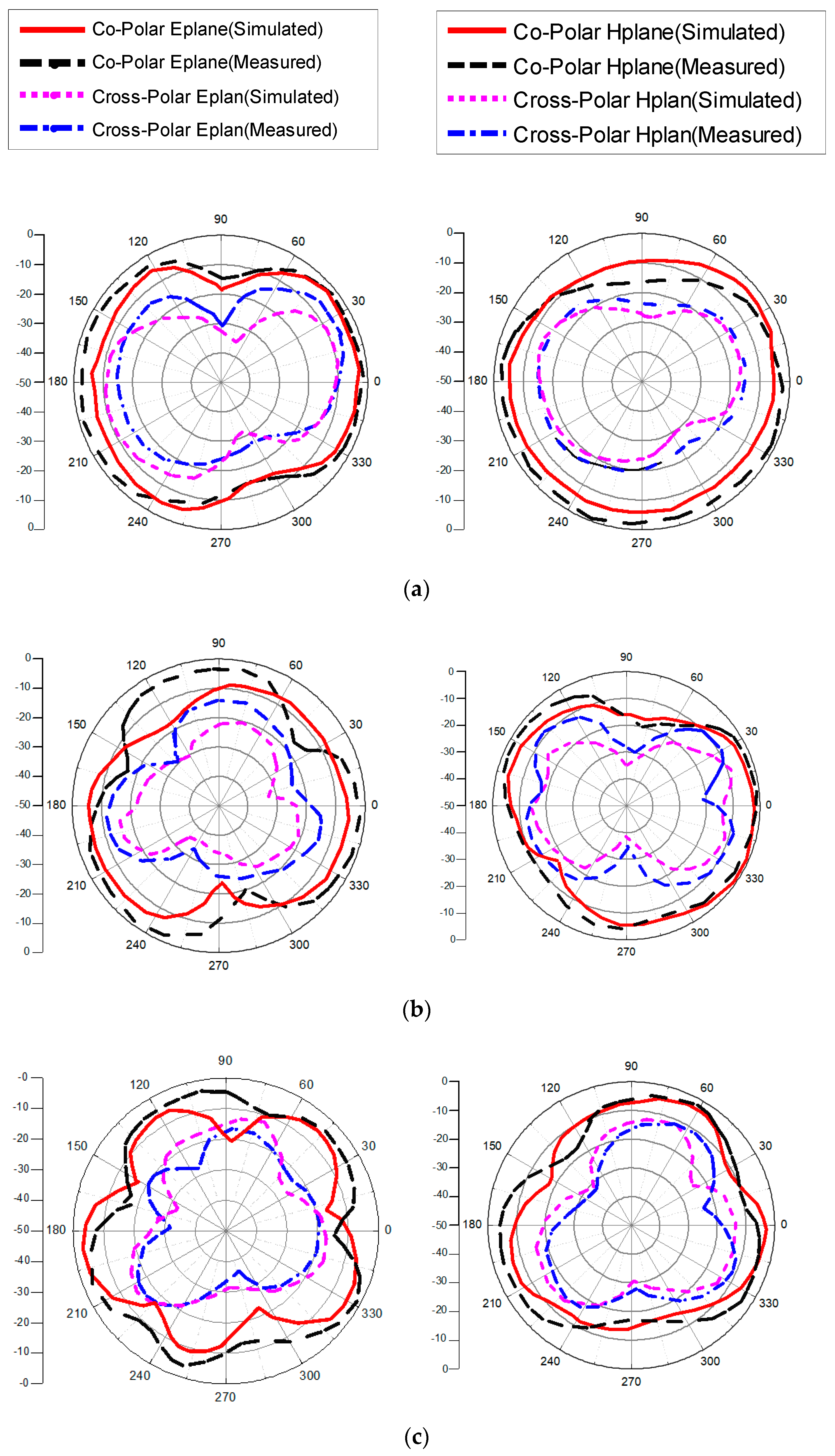

| Parameter | Dimension (mm) | Parameter | Dimension (mm) |
|---|---|---|---|
| L | 30 | Y5 | 3 |
| W | 20 | R1 | 5 |
| X1 | 0.5 | R2 | 1 |
| X2 | 8.25 | G1 | 1 |
| X3 | 3 | A1 | 7 |
| X4 | 1 | A2 | 8 |
| Y1 | 12 | X5 | 9 |
| Y2 | 12.1 | X6 | 7.5 |
| Y3 | 9 | X7 | 3 |
| Y4 | 21 | X8 | 0.5 |
| Ref. | Bandwidth | Dimensions | Isolation (dB) | ECC | ||
|---|---|---|---|---|---|---|
| GHz | Ratio | mm2 | λL × λL (Lower Frequency) | |||
| [2] | 3–18 | 6:1 | 40 × 40 | 0.30λ × 0.30λ | >20 | <0.03 |
| [17] | 2.8–20 | 7.1:1 | 17.7 × 30.7 | 0.13λ × 0. 23λ | >22 | <0.005 |
| [18] | 3.2–11 | 3.4:1 | 36 × 36 | 0.27λ × 0. 27λ | >15 | <0.005 |
| [19] | 2–10.6 | 5.3:1 | 45 × 45 | 0.34λ × 0. 34λ | >17 | <0.005 |
| [20] | 3–15 | 5:1 | 38 × 38 | 0.29λ × 0. 29λ | >20 | <0.005 |
| [21] | 2.9–40 | 13.7:1 | 58 × 58 | 0.44λ × 0. 44λ | >17 | <0.04 |
| [22] | 1.3–40 | 30.7:1 | 56 × 56 | 0.43λ × 0. 43λ | >22 | <0.03 |
| [23] | 2.24–30 | 13.3:1 | 45 × 90 | 0.34λ × 0. 69λ | >10 | N-A |
| [24] | 3.5–4.4, 6–20 | 4.5:1 | 67 × 67 | 0.51λ × 0.51λ | >20 | <0.05 |
| [25] | 0.96–35 | 36:1 | 63 × 63 | 0.48λ × 0.48λ | >17 | <0.01 |
| [26] | 1.3–40 | 31:1 | 63 × 63 | 0.48λ × 0.48λ | >16 | <0.05 |
| [27] | 3.1–20.3 | 6.4:1 | 50 × 50 | 0.38λ × 0.38λ | >20 | <0.05 |
| [28] | 3–40 | 13.3:1 | 18 × 36 | 0.13λ × 0.27λ | >18 | <0.01 |
| [29] | 3.8–51 | 13.3:5 | 31 × 31 | 0.23λ × 0.23λ | >15 | <0.075 |
| Proposed | 2.3–23 | 10:1 | 60 × 55 | 0.46λ × 0.42λ | >20 | <0.002 |
Publisher’s Note: MDPI stays neutral with regard to jurisdictional claims in published maps and institutional affiliations. |
© 2022 by the authors. Licensee MDPI, Basel, Switzerland. This article is an open access article distributed under the terms and conditions of the Creative Commons Attribution (CC BY) license (https://creativecommons.org/licenses/by/4.0/).
Share and Cite
Khurshid, A.; Dong, J.; Ahmad, M.S.; Shi, R. Optimized Super-Wideband MIMO Antenna with High Isolation for IoT Applications. Micromachines 2022, 13, 514. https://doi.org/10.3390/mi13040514
Khurshid A, Dong J, Ahmad MS, Shi R. Optimized Super-Wideband MIMO Antenna with High Isolation for IoT Applications. Micromachines. 2022; 13(4):514. https://doi.org/10.3390/mi13040514
Chicago/Turabian StyleKhurshid, Adnan, Jian Dong, Mir Swad Ahmad, and Ronghua Shi. 2022. "Optimized Super-Wideband MIMO Antenna with High Isolation for IoT Applications" Micromachines 13, no. 4: 514. https://doi.org/10.3390/mi13040514
APA StyleKhurshid, A., Dong, J., Ahmad, M. S., & Shi, R. (2022). Optimized Super-Wideband MIMO Antenna with High Isolation for IoT Applications. Micromachines, 13(4), 514. https://doi.org/10.3390/mi13040514








